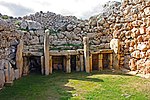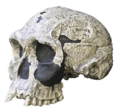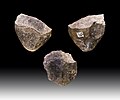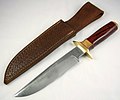The Oldowan (or Mode I) was a widespread stone tool archaeological industry (style) in prehistory. These early tools were simple, usually made by chipping...
63 KB (7,389 words) - 11:45, 28 July 2024
Stone tool (section Mode I: The Oldowan Industry)
media related to Oldowan. The earliest stone tools in the era of genus Homo are Mode 1 tools, and come from what has been termed the Oldowan Industry, named...
35 KB (3,987 words) - 12:07, 14 July 2024
Stone Age (section Oldowan in Africa)
split, creating an Oldowan tool, the tradition may well be far older than its current record.[citation needed] Towards the end of Oldowan in Africa a new...
79 KB (10,305 words) - 10:31, 23 June 2024
Gona, Ethiopia (section Oldowan technological behavior)
documented Oldowan artifact assemblages. Archaeologists have since found older examples of the Oldowan at other sites. Still, Gona's Oldowan assemblages...
46 KB (5,177 words) - 08:12, 4 July 2024
and female size is not definitively known. H. habilis manufactured the Oldowan stone-tool industry and mainly used tools in butchering. Early Homo, compared...
51 KB (6,230 words) - 19:26, 22 July 2024
abundance of faunal remains the Leakeys found stone tools Mary classified as Oldowan. In May 1960, at the FLK North-North site, the Leakeys' son Jonathan found...
30 KB (3,714 words) - 05:47, 2 May 2024
in the Olduvai Gorge in Tanzania by Louis Leakey in the 1930s. The name Oldowan was given to the tools after the site in which they were excavated. These...
7 KB (1,098 words) - 22:21, 4 December 2023
current archaeological record, until around 300,000 years ago, spanning the Oldowan ("mode 1") and Acheulean ("mode 2") lithics industries. In African archaeology...
15 KB (1,790 words) - 23:05, 10 June 2024
first developed about 2 million years ago, derived from the more primitive Oldowan technology associated with Homo habilis. The Acheulean includes at least...
42 KB (4,899 words) - 22:14, 31 May 2024
The flakes would have been used as crude knives or scrapers. Unlike the Oldowan tools from which Clactonian ones derived, some were notched, implying that...
8 KB (841 words) - 23:48, 28 July 2024
[better source needed] The first human settlement on Russia dates back to the Oldowan period in the early Lower Paleolithic. About 2 million years ago, representatives...
370 KB (33,421 words) - 19:49, 28 July 2024
The invention of the sharp-edged Oldowan may be tied to unique biological changes in Homo. It is unclear if the Oldowan developed independently or from...
7 KB (804 words) - 04:27, 22 July 2024
contemporaneous Oldowan site is documented at Garba IV. The magneto-stratigraphic sequence of Jaramillo lies between Tuff A, which overlies the Oldowan sites,...
7 KB (1,049 words) - 07:18, 25 June 2024
late Early Pleistocene, around 1 mya. Often at these sites tools from the Oldowan industry are present. At Kilombe and Buia, it is unclear whether the hippos...
12 KB (1,113 words) - 15:44, 26 June 2024
ISBN 9784431545118. Semaw, S; Rogers, M; Stout, D (2009). "Oldowan–Acheulian transition: Is there a Developed Oldowan artifact tradition?". In Camps, M; Chauhan, P...
5 KB (549 words) - 16:19, 2 July 2024
sharp-edged tools for cutting. The earliest Paleolithic stone tool industry, the Oldowan, began around 2.6 million years ago. It produced tools such as choppers...
107 KB (11,381 words) - 00:36, 6 July 2024
than gracile australopithecines. P. boisei may have been able to make Oldowan stone tools and butcher carcasses. P. boisei mainly inhabited wet, wooded...
59 KB (7,163 words) - 21:01, 17 July 2024
a protein domain Olduvai, Research Facility on Mars in the Doom (film) Oldowan This disambiguation page lists articles associated with the title Olduvai...
327 bytes (75 words) - 19:19, 22 December 2023
19 to 205 mm (0.75 to 8.07 in) in length, normally shorter than later Oldowan industry flakes. Anvils were heavy, up to 15 kg (33 lb). Flakes seem to...
26 KB (3,375 words) - 03:53, 29 May 2024
changes. Arabia has a rich Lower Paleolithic record, and the quantity of Oldowan-like sites in the region indicate a significant role that Arabia had played...
307 KB (28,089 words) - 02:10, 26 July 2024
-Selassie Y (June 1994). "African Homo erectus: old radiometric ages and young Oldowan assemblages in the Middle Awash Valley, Ethiopia". Science. 264 (5167):...
267 KB (25,496 words) - 01:29, 28 July 2024
Homo has been taken to coincide with the first use of stone tools (the Oldowan industry), and thus by definition with the beginning of the Lower Palaeolithic...
92 KB (7,996 words) - 05:20, 28 July 2024
have separated Homo from predecessors.) A. garhi possibly produced the Oldowan industry which was previously considered to have been invented by the later...
17 KB (2,043 words) - 01:52, 14 November 2023
around 200 million years ago. Early Stone Age Acheulean stone artefacts and Oldowan tools were excavated at archaeological sites around the falls, as well...
41 KB (4,427 words) - 12:27, 26 July 2024
the area. The oldest specimen of Homo, LD 350-1, is associated with the Oldowan stone tool industry, meaning this tradition had been in use by the genus...
32 KB (3,893 words) - 16:38, 7 June 2024
Homo erectus, some 1.8 million years ago, replacing the more primitive Oldowan industry used by A. garhi and by the earliest species of Homo. The Middle...
45 KB (4,807 words) - 13:07, 6 July 2024
The country has remained relatively stable since then. The presence of Oldowan artifacts in West Africa was confirmed by Michael Omolewa, attesting to...
167 KB (14,560 words) - 16:58, 28 July 2024
humanity, knives appeared at least 2.5 million years ago, as evidenced by the Oldowan tools. Originally made of wood, bone, and stone (such as flint and obsidian)...
40 KB (5,311 words) - 20:34, 7 July 2024
earliest of the dated is Ain Hanech in northern Algeria (c. 1.8 – 1.2 Ma), an Oldowan grade layer. These sites attest that early Homo erectus have crossed the...
55 KB (6,048 words) - 04:40, 22 May 2024
of the first written records in Classical Antiquity in Greece. In 2010, Oldowan flint tools were discovered at Bayraki that are 800,000–1.2 million years...
313 KB (28,258 words) - 08:22, 26 July 2024

























